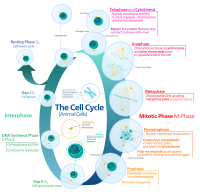
Photo from wikipedia
Abstract The transport of two-phase (air/water) was experimentally investigated in a semi-open pump impeller of radial type. The influence of increasing the tip clearance gap and installing an upstream inducer… Click to show full abstract
Abstract The transport of two-phase (air/water) was experimentally investigated in a semi-open pump impeller of radial type. The influence of increasing the tip clearance gap and installing an upstream inducer on the pump performance were thoroughly investigated and compared, helping to select the optimal operation based on the considered flow conditions. Three experimental procedures were used to set the desired flow conditions to check a possible hysteresis due to gas accumulation. The head degradation, pump surging and flow instabilities were investigated for all cases. The whole pump was made of transparent acrylic glass, providing high-quality flow visualization. The two-phase flow regimes were recorded and identified using a high-speed camera. For single-phase flow, the results show a considerable performance reduction for the increased gap, while the inducer has only insignificant effects. For gas volume fractions within 1 % ⩽ e ⩽ 3 % , the performance deterioration of the semi-open impeller with standard gap is very gradual. However, the performance is strongly reduced for e ⩾ 4 % due to the onset of big gas accumulations in the impeller. The abrupt performance drop could be delayed to e = 7 % for the increased gap. Similarly, installing the inducer resulted in more robust performance up to e = 5 % and e = 7 % for overload and part-load flow conditions, respectively. For e ⩾ 8 % , the performance is very low in all cases due to the occurrence of gas-locking phenomenon. Comparing different experimental procedures, obvious performance hysteresis could be seen within 4 % ⩽ e ⩽ 6 % when the standard gap is used. However, installing the inducer could strongly reduce the performance hysteresis, while increasing the gap could completely eliminate it. Flow instabilities and pump surging occur mainly in overload conditions for 4 % ⩽ e ⩽ 5 % . Having the inducer installed could positively damp the instabilities and reduce the surging region. The obtained two-phase maps show the strongly increased resistance to gas accumulation for the larger gap and the moderately improved resistance when installing the inducer. All the obtained experimental results are used for checking and validating CFD numerical models in a companion study.
Journal Title: Experimental Thermal and Fluid Science
Year Published: 2018
Link to full text (if available)
Share on Social Media: Sign Up to like & get
recommendations!